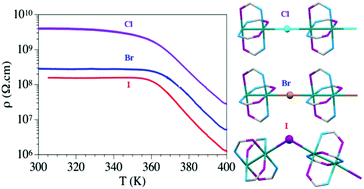Structural, magnetic and electrical properties of one-dimensional tetraamidatodiruthenium compounds†
Abstract
The first bromo and iodo tetraamidatodiruthenium compounds of the type [Ru2X(μ-NHOCC6H4-R)4]n [X = Br, R = o-Me (1), m-Me (2), p-Me (3); X = I, R = o-Me (4), m-Me (5), p-Me (6)] have been prepared using solvothermal or microwave activation procedures. In these reactions ethanol or methanol as solvents have been used to make the synthesis procedures more environment-friendly. Solvothermal synthesis has allowed us to isolate single crystals of these extremely insoluble compounds and the crystal structures of all of them have been determined using single crystal X-ray diffraction. The change of the bridging halide ligand permits us to discuss the properties of these complexes on the basis of their structure. Complex 1 shows a Ru–Br–Ru angle of 180.0° whereas in complexes 2–6 the Ru–X–Ru angle varies from 110.16(2) to 115.39(4)°. In all compounds the ruthenium atom has a cis-RuN2O2 environment except in compound 1 that shows a positional disorder of N and O atoms. The bromide complex 1 shows a linear arrangement of the paddlewheel units in the resulting 1D coordination polymer. The fit of the magnetic data indicates that these compounds have non-negligible values of zero-field splitting with D values ranging from 41.10 to 60.10 cm−1 and antiferromagnetic coupling constants from 0.00 to −4.13 cm−1. Compound 1 is the first linear paddlewheel diruthenium compound that does not show a maximum in the representation of the magnetic susceptibility towards temperature. The electrical conductivity measurements in the temperature range 300–400 K of compounds 1, 4 and [Ru2Cl(μ-NHOCC6H4-o-Me)4]n (7) show that these compounds present semiconducting behaviours with conductivity values at 400 K in the range 0.3–3.0 × 10−8 S cm−1 for the Cl derivative (7), 7–18 × 10−8 S cm−1 for the Br derivative (1) and 27–68 × 10−8 S cm−1 for the I derivative (4) with average values of 1.4 × 10−8, 13 × 10−8 and 47 × 10−8 S cm−1, respectively.


 Please wait while we load your content...
Please wait while we load your content...